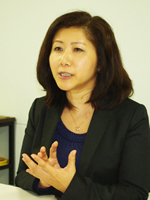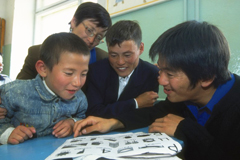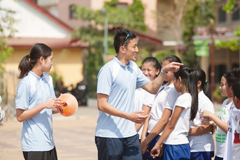InterviewJICA-RI Focus Vol. 38 - Interview with Research Fellow Yuriko Kameyama
2017.01.04
There are 17 goals that should be achieved by 2030 included in the “Sustainable Development Goals” (SDGs) that were adopted in 2015, one of which is to “Ensure inclusive and equitable quality education and promote lifelong learning opportunities for all (Goal 4).” Educating children is one of the significant challenges of international cooperation.
Research Fellow Yuriko Kameyama has been involved in researching educational development, the results of education, the results of learning, and access to education in developing countries. Since 2014, she has been conducting research on “Disabilities and Education,” and since 2015, “Analysis of the Current Status and Issues of Parental Support for Children’s Learning in the Early Grades: Case Study of Cambodia.” We asked her about the purpose and findings of the two research projects, and the meaning of learning.
Profile:
After working for the International Development Center of Japan (IDCJ) and Save the Children Japan, Kameyama took her current post in 2011.

- What are the aim and findings of “Disabilities and Education”?
Ensuring that children with disabilities have the opportunity to receive an education is a significant issue in providing all children access to elementary education. However, past research on disabilities and education has mainly consisted of comparing policies and philosophies and case studies of implementing education, and empirical research is limited. In developing countries in particular, there is almost no data that would give us an understanding of the education of children with disabilities. This research examines the type of influence that special education, inclusive education, and other differing forms of education have on children who have disabilities and those who do not, as well as the views of teachers, parents, and guardians regarding the forms of education. I do this from the perspectives of human rights, cost-effectiveness, and pedagogy.
The target countries are Mongolia, Cambodia, Nepal, and Thailand. In Mongolia and Cambodia, I conducted an investigation based on a questionnaire for teachers, parents and guardians of children who have disabilities, and parents and guardians of children who do not. I also investigated the parents and guardians of children with disabilities who do not attend school despite being of the age to attend elementary school. I utilized interviews in Nepal, and focused on education and sports in Thailand.
One of the objectives of this study is to clarify the actual situation of education for children with disabilities. In many developing countries, children with disabilities and those without study in the same classroom. However, this differs a bit from the inclusive education spoken of in the developed world, in which all children learn together. Because there is no option for a self-contained classroom, in some aspects it is simply the way it has to be. Even in the same classroom, it is difficult for children with disabilities to receive appropriate guidance, and frequently the child is merely there. I plan to conduct an analysis of how the teachers, parents, and guardians at the site of education view the current situation, based on my investigation.
Another objective is to reflect the data I have collected in my investigation in educational policy. In developing countries, there is almost no information regarding children with disabilities who do not attend school. In my current investigation, I am also asking about the socio-economic backgrounds of the families, the reason the children do not attend school, and what they do instead of going to school. As a result, in Mongolia for example, the lack of a means of transportation and insufficient understanding of others around them are some of the reasons for not attending school. I would like to use my findings as the basic information for policy discussions of what specifically should be done to ensure that children with disabilities have the opportunity to receive an education under the major goals of Education for All (EFA) and the SDGs.
As a result of my investigation, I found that, in Mongolia, children who are behind in their education due to poverty rather than disabilities are attending special-needs schools in some cases. The lack of understanding of the community and schools toward children with disabilities was evident as well. Children with physical disabilities can move from classroom to classroom and exercise in physical education classes if they have a little help or a tool, but teachers do not have the requisite knowledge, making them unable to help.
In my interviews of the parents and guardians of children with disabilities in Mongolia, I heard about a child who “would be allowed to attend school if he was accompanied by a parent the entire time.” There is also a significant burden on teachers who instruct both children with disabilities and those without in the same regular class. Teachers themselves are not given instruction on how to teach children with disabilities in the first place, and there are no teachers nearby who can share examples of what they did that succeeded. They also do not interact with teachers who instruct children with disabilities in separate classrooms. If regular schools are going to accept children with disabilities and implement inclusive education, it is necessary not only to change the treatment of teachers, but also to build a system that unifies the schools and the communities.
- What are the background and aim of “Analysis of the Current Status and Issues of Parental Support for Children’s Learning in the Early Grades: Case Study of Cambodia”?
In recent years, developing countries have begun participating in the Trends in International Mathematics and Science Study (TIMSS) and the Programme for International Student Assessment (PISA). In conjunction, the problem of low academic achievement in developing countries has been conspicuous. The Early Grade Reading Assessment (EGRA) also shows that many children fail to learn the basics in the early grades of primary education, which could lead to a greater number of dropouts. One of the significant types of support believed to be effective in improving the academic abilities of such children is the support of parents and guardians for learning. In this study, I plan to administer an achievement test to children and a questionnaire to parents, guardians, children and teachers. To propose concrete support action, I will use the data obtained through this investigation to analyze the available time, money and support that parents can receive, as well as the current state of education support provided by parents and guardians, and children's cognitive and non-cognitive abilities..

Mongolian children
(Photo: JICA/Kenshiro Imamura)
Education and achievement gaps are not the fault of the individual, but are created by the place and environment into which the individual was born. In some cases the cause is a lack of awareness by parents and guardians, but there is also a significant problem with the environment of parents and guardians as well. Not only the income of the parents or guardians, but also the amount of association with their children and the availability of time to interact as parent and child are involved. If income is low, the parent must work. Work hours increase, necessitating a decrease in the amount of time available for interaction with children. The presence of relatives nearby who can support the parents or guardians and whether the community has a deeply rooted sense of support also have an impact. In the rural areas of developing countries, there is a problem of children being left alone while parents go to an urban area or overseas to work.
In my study, I plan to conduct interviews not only concerning academic ability, but also the degree of happiness, satisfaction, self-esteem, and other non-cognitive abilities that are difficult to measure with that alone. I would like to conduct my research in order to show that the responsibility for inequitable education of children lies not only on parents and guardians, and to make recommendations regarding public support and community strength that can correct these inequities.
- What is the role of the community in education?
As part of my investigation of the support of parents and guardians for learning, I visited Higashinaruse Village in Akita Prefecture, Japan. Akita Prefecture has remained at the top of the National Assessment of Academic Ability (academic test) conducted by the Ministry of Education, Culture, Sports, Science and Technology, since its inception in 2007. The top academic abilities in Akita Prefecture are boasted by the village. The reason I visited Higashinaruse Village was that I wanted to learn what role the community played in education.
What I determined through interviews with the superintendent of schools and parents and guardians was that the entire community supported the schools. For example, local residents proactively offer their cooperation as assistant teachers, after-hours book lending, and in other ways. The large majority of village residents are registered as volunteers to support the schools.
It is certain that in some aspects this was possible due to the foundation of trust in the community that developed over multiple generations that can only be found in rural areas, and because few problems were taken into the schools. However, this does not mean that the level of education will increase if the community is functioning. One thing that impressed me was the words of a teacher whose burden had been reduced after being assigned to a school in Higashinaruse Village. When she was working at a different school, it was a matter of course that she would arrive home late at night. It is quite common for teachers in Japan to work long hours. But at the school in Higashinaruse Village, she was able to return home at about 7:00 PM. This was possible due to thorough implementation of the policy of the principal, vice principal, and board of education to refrain from giving teachers non-teaching duties in order to allow them to focus on teaching. I felt that education in Higashinaruse Village took the ideal form, with the community functioning, trust in the schools, and children receiving the benefits of public education.
- What is the true meaning of learning?
In recent years, international educational cooperation has tended to take the view that TIMSS and PISA scores constituted the level of education in that country. However, I believe that the academic abilities expressed by academic test scores are only one part of learning. When thinking about the quality of education, scores are not everything, although they are one indicator. Because international comparisons through TIMSS and PISA are expressed so symbolically, I fear that there is panic over fluctuation in scores.

Cambodian children
(JICA/Shinichi Kuno)
There are many aspects of education that cannot be measured in numbers. For example, in the case of Mongolia, the knowledge needed by children in nomadic groups is completely different from that needed by children living in the capital city Ulaanbaatar. This means that the learning that is likely to be of use should also differ between nomads and children living in Ulaanbaatar. The level of achievement measured by TIMSS and PISA is probably not very important to nomad children, and it may be fine for the content of textbooks to differ as well. Improvement is important, but the learning that keeps children alive differs for each person. For that reason in particular, I have doubts about comparing them with a single measuring stick.
What I feel a sense of urgency about right now is education in Japan. Although the level of education is higher than other countries when the degree of achievement indicated by TIMSS and PISA scores and the rate of advancement to higher education are compared, the level of self-affirmation of children is lower than in other countries, and the difference increases with age. In addition, the relative poverty rate of children is higher than the average for OECD member countries, and the gap in education is growing accordingly. Isn't education in Japan disconnected from learning children need to live? Researching education in developing countries has also shown me many common problems in education in Japan.
One of the Millennium Development Goals (MDGs) is the goal to “Ensure that all boys and girls complete a full course of primary schooling.” Achievement of the goal of increasing access to education can be measured numerically by things such as enrollment rate and attendance rate, and in a sense was easy to understand. However, the SDG goal of “Ensure inclusive and equitable quality education and promote lifelong learning opportunities for all” cannot be measured fully with numbers alone. I believe that, as researchers, we should conduct our research with an understanding of that. Being a parent myself, I understand that numerically measured ability is merely one part of children's ability. I hope to contribute to the creation of an environment that will maximize the potential of all children.

事業事前評価表(地球規模課題対応国際科学技術協力(SATREPS)).国際協力機構 地球環境部 . 防災第一チーム. 1.案件名.国 名: フィリピン共和国.

事業事前評価表(地球規模課題対応国際科学技術協力(SATREPS)).国際協力機構 地球環境部 . 防災第一チーム. 1.案件名.国 名: フィリピン共和国.

事業事前評価表(地球規模課題対応国際科学技術協力(SATREPS)).国際協力機構 地球環境部 . 防災第一チーム. 1.案件名.国 名: フィリピン共和国.

事業事前評価表(地球規模課題対応国際科学技術協力(SATREPS)).国際協力機構 地球環境部 . 防災第一チーム. 1.案件名.国 名: フィリピン共和国.

事業事前評価表(地球規模課題対応国際科学技術協力(SATREPS)).国際協力機構 地球環境部 . 防災第一チーム. 1.案件名.国 名: フィリピン共和国.
scroll